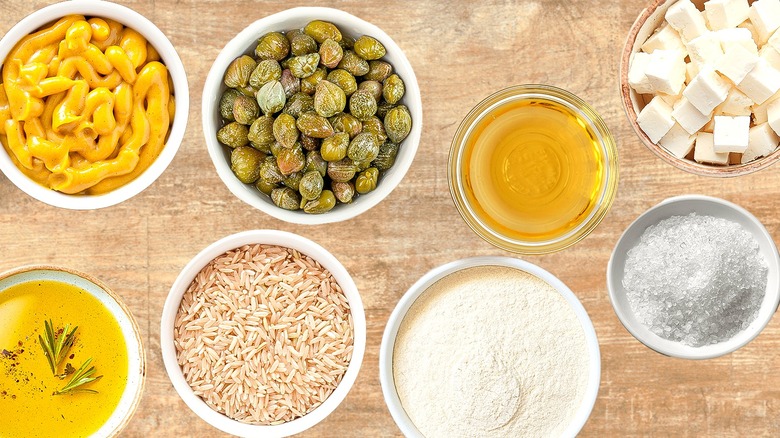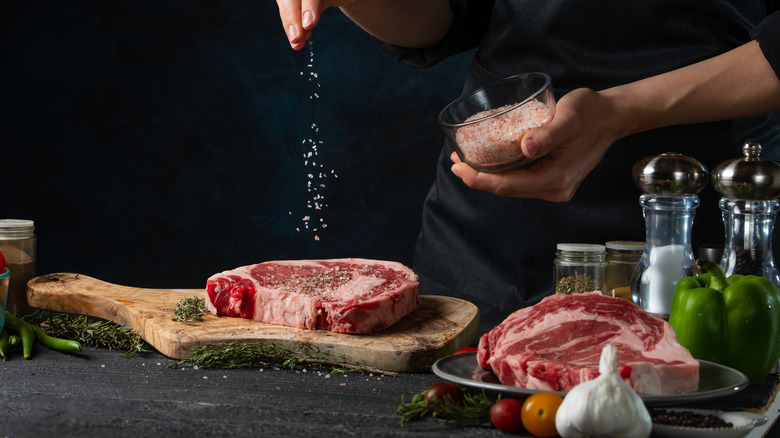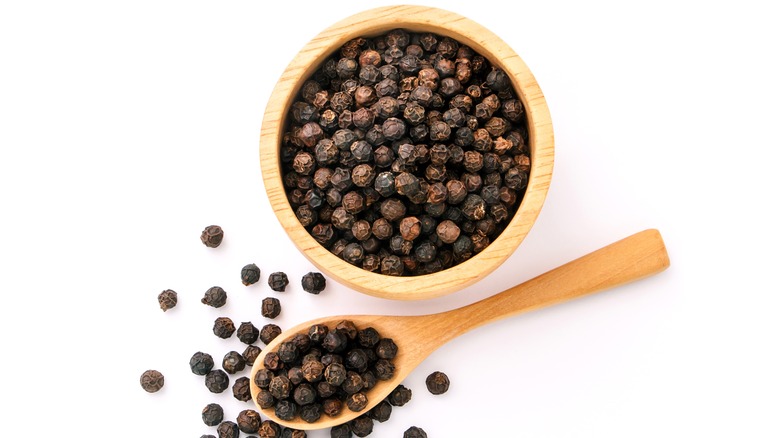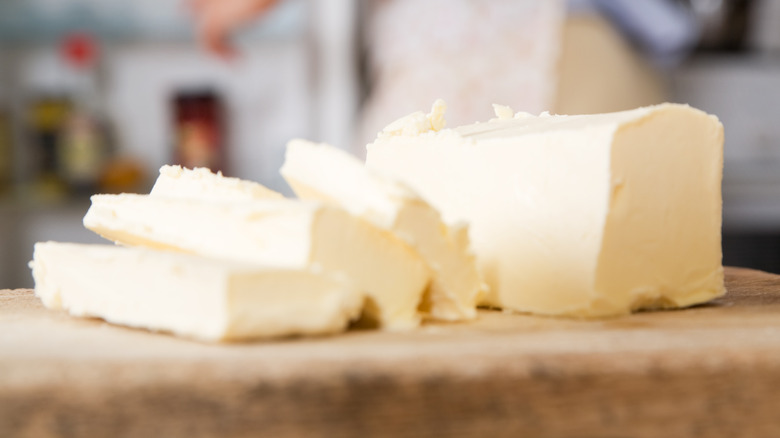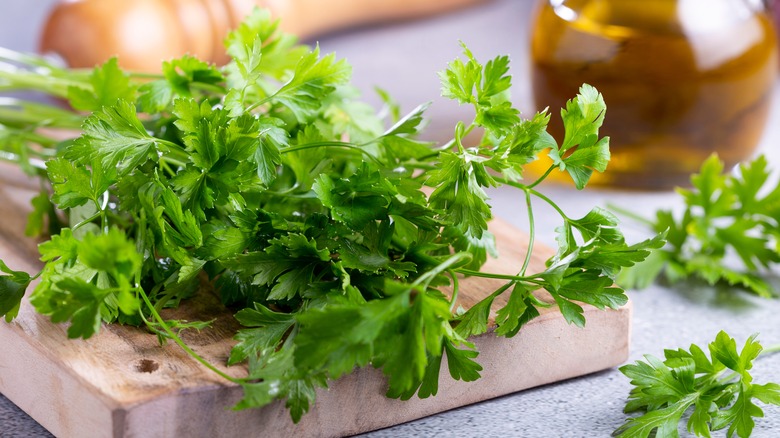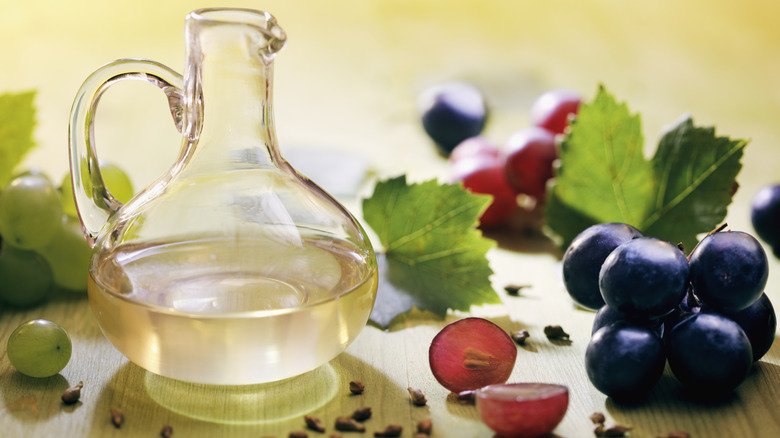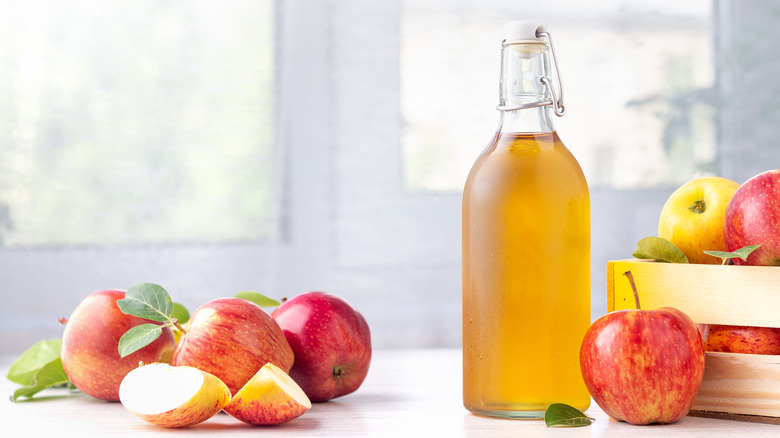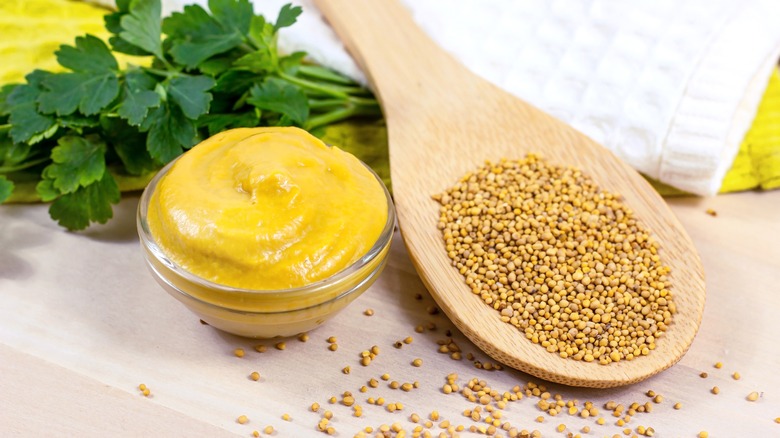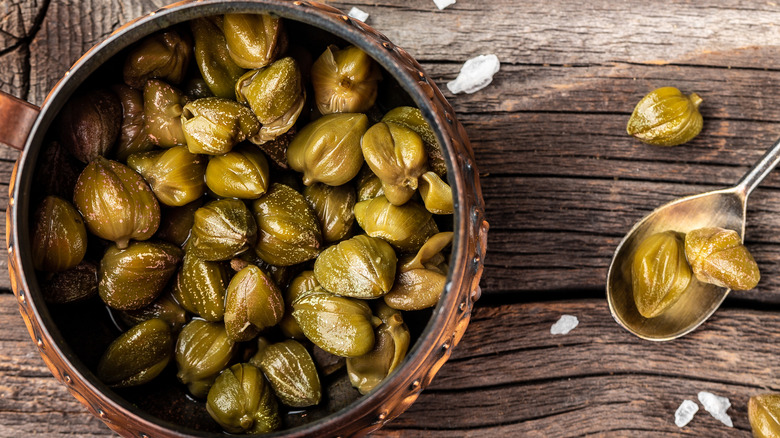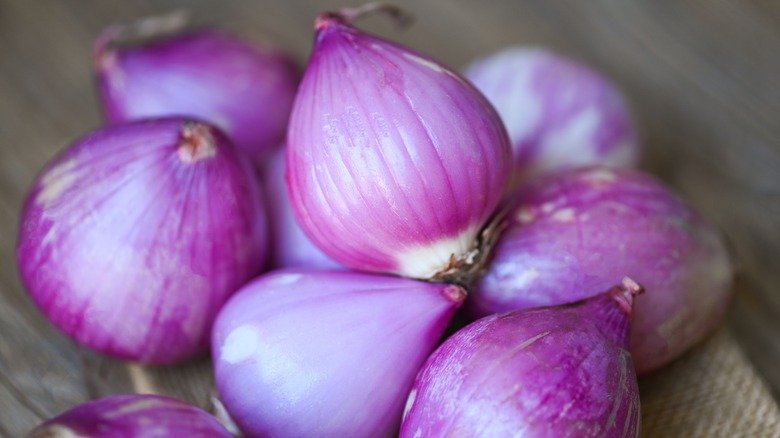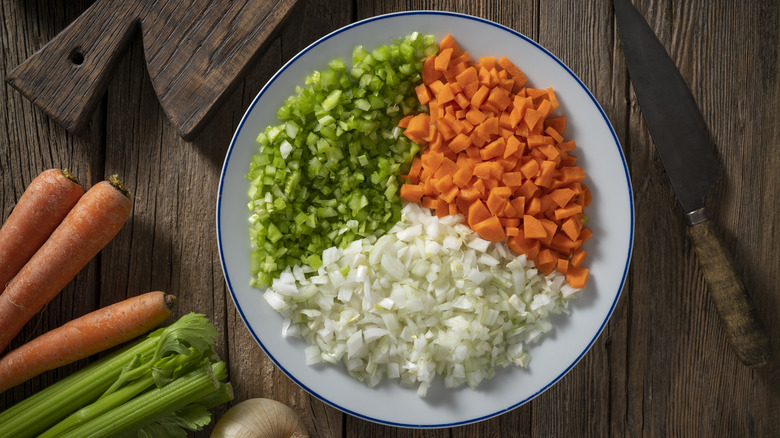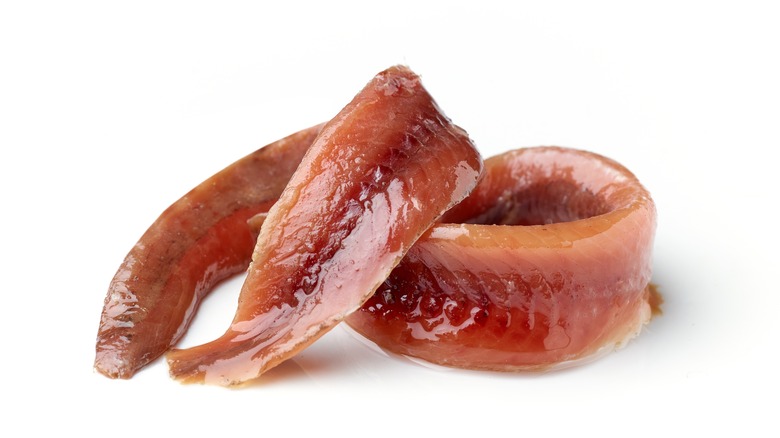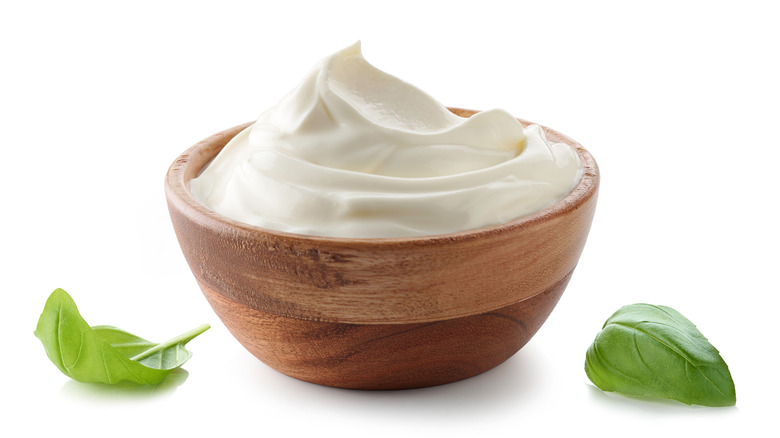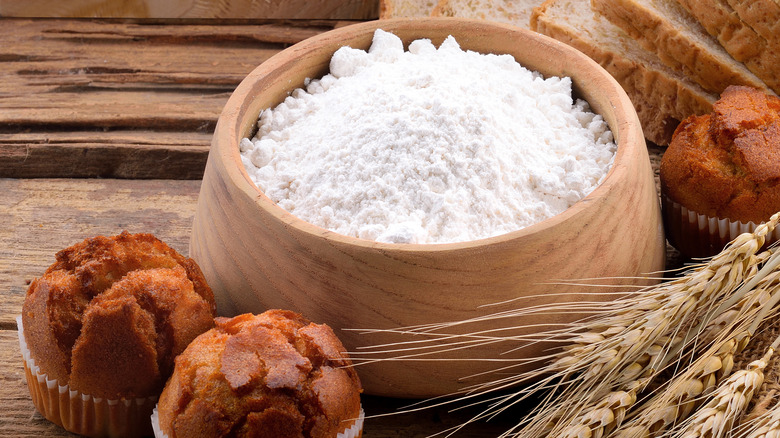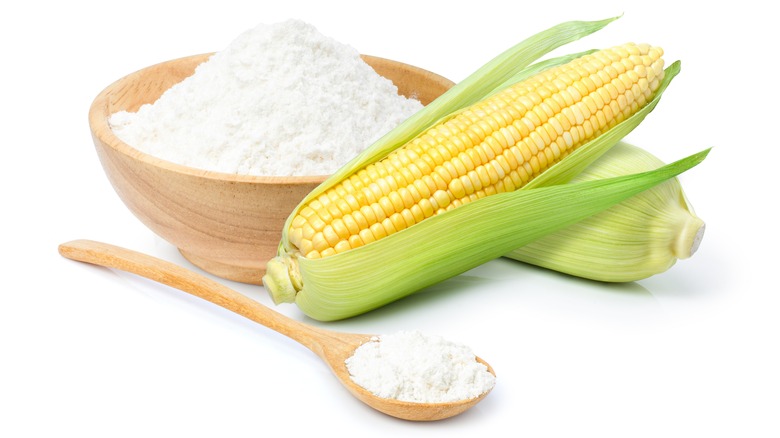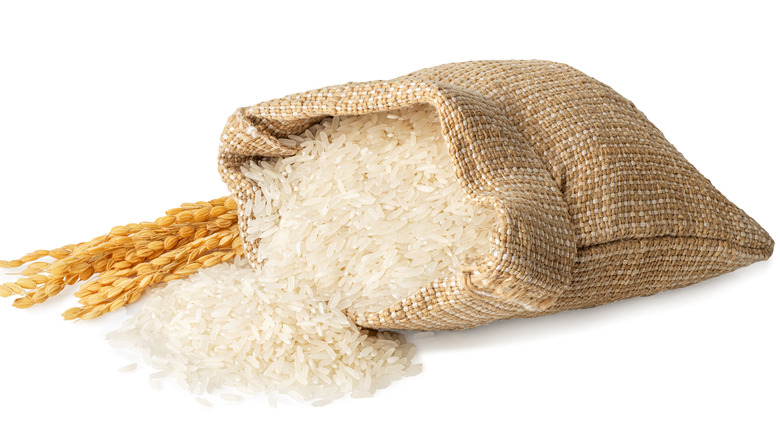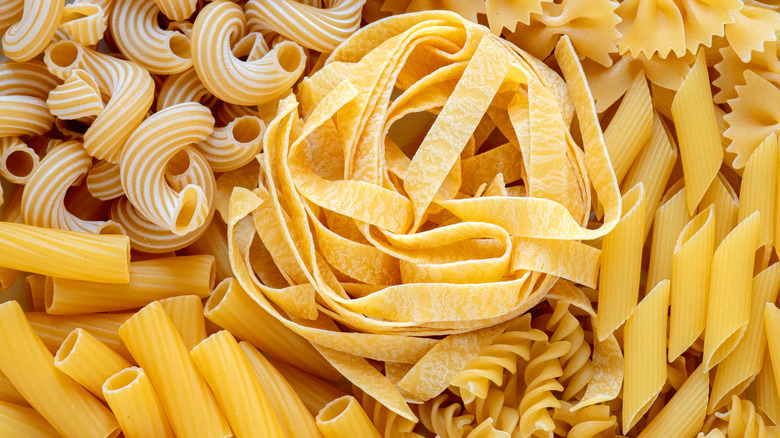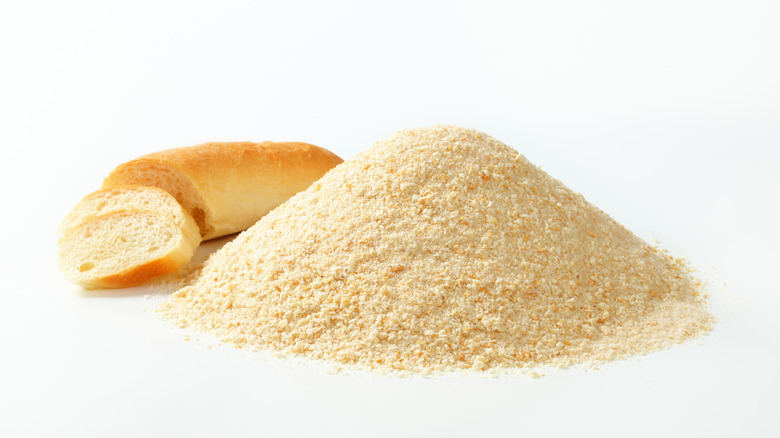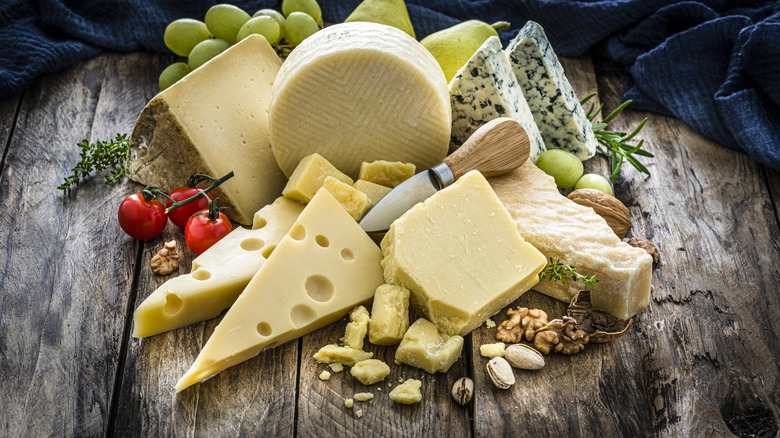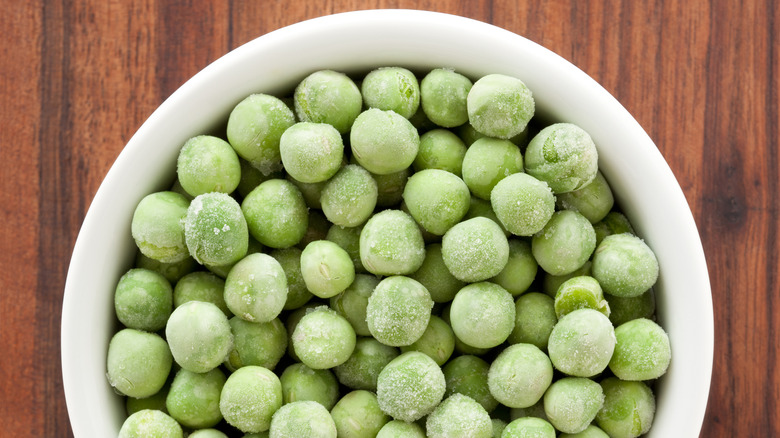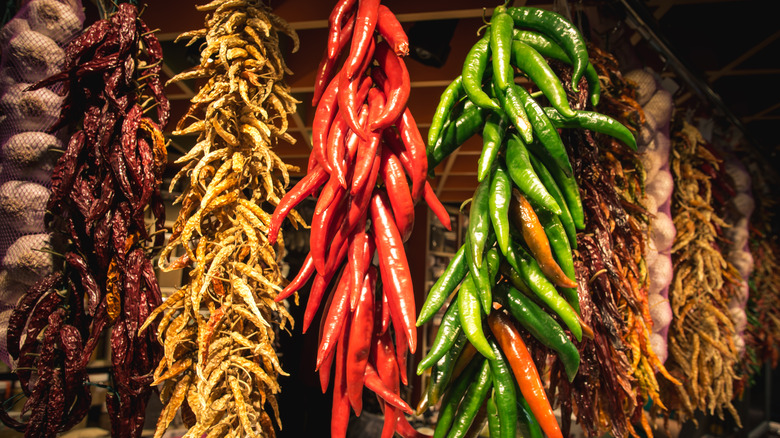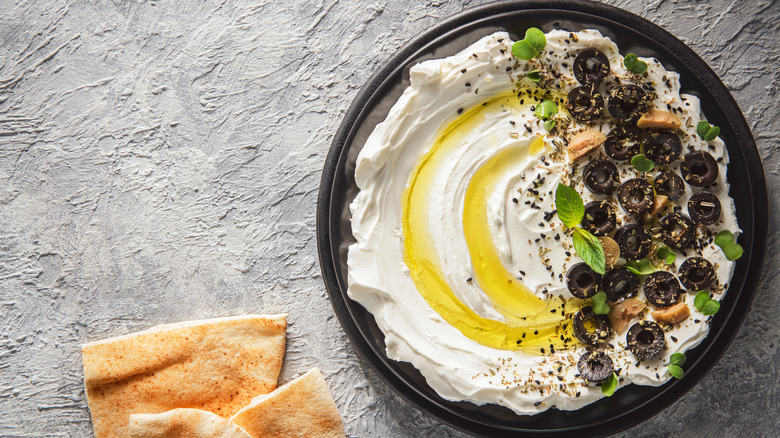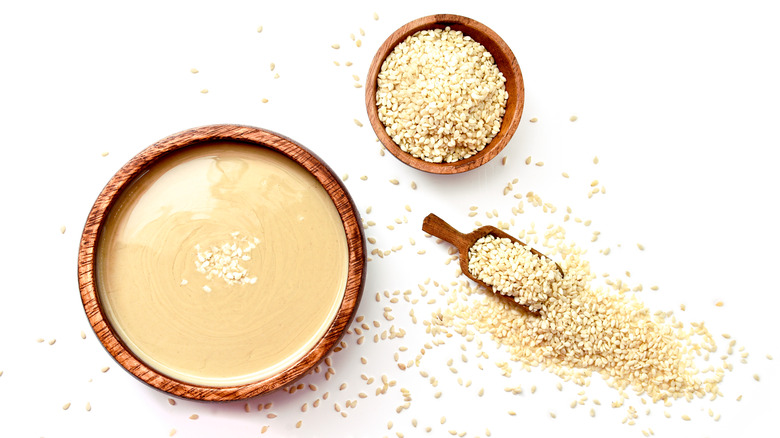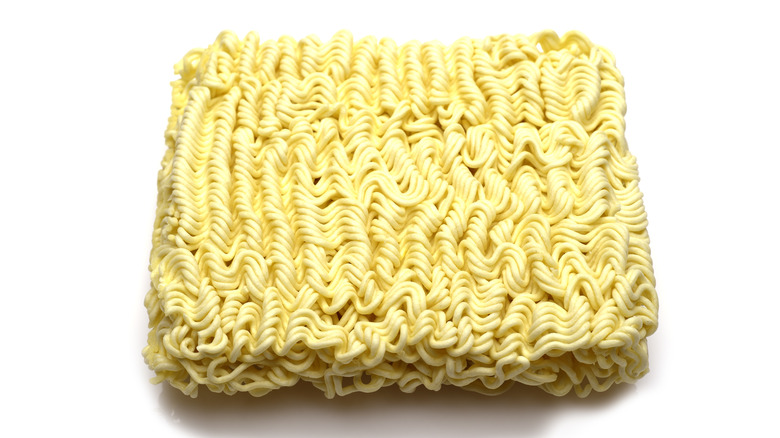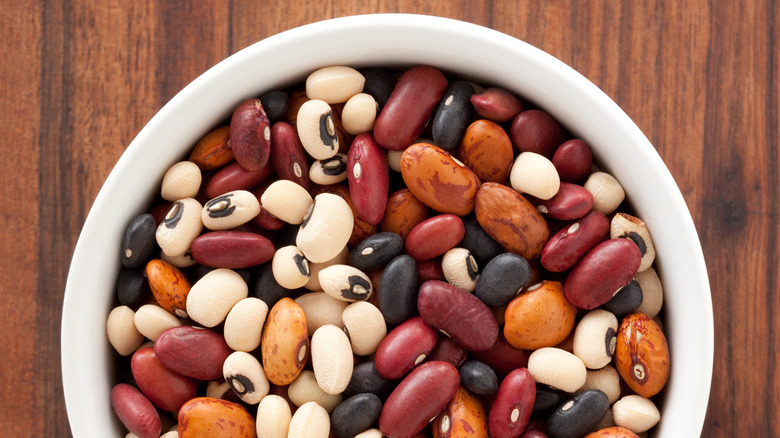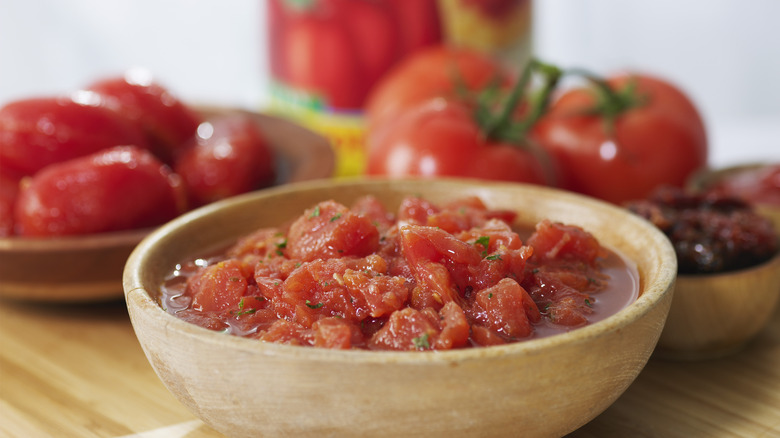30 Essential Ingredients Every Beginner Cook Needs To Have On Hand
Getting started with cooking can be daunting. First, there is navigating the amount of equipment to execute an intimidating number of techniques. Then there are ingredients. While a well-stocked spice cabinet and a refrigerator filled with ingredients are great, assembling your stockpile in slow, easily attainable steps is more manageable for you and your bank account.
We've compiled a list of staple ingredients that will help you with a wide range of recipes, all useful for multiple recipes and cuisine types, as beginner cooks don't need single-purpose ingredients. This list's intent is inspirational and aspirational; there is no need to buy every one of these ingredients before you start cooking, so view this as something to build to rather than a "must-have before you can start" list. Most of these ingredients fall into the affordable category, and many of them have long shelf lives, so you needn't worry about them going bad before you find a use for them. If any are hard and fast requirements, it is the first ingredient on the list, so please start there.
1. Salt
One of the hardest lessons as a young cook was the importance of salt. Salt is more than just a flavoring; appropriately used, it amplifies the food's flavor and builds depth to your dish. As a catalyst for osmosis, adding the right amount of salt at the right time allows the process to draw the salt into the food, enhancing it without tasting "salty." We recommend having at least two salts in your pantry: coarse sea salt for general seasoning and finishing salt, like pink Himalayan or Maldon salt, to add a touch of salinity to your end product.
2. Black pepper
Black pepper has a smoky, slightly spicy flavor that intensifies as it blooms and appears in cuisines worldwide. Unlike chiles which contain capsaicin, black pepper's heat comes from a compound called piperine, which is neither as intense nor long-lasting. Don't just sprinkle pepper on along with salt; use it with intention. Pepper is best when fat-activated, like in cacio e pepe or country sausage, and burns at high heat, so it's not a spice you want to add before searing a piece of food. Get an inexpensive grinder and whole peppercorns to always have fresh pepper on hand.
3. Butter
Butter is an incredibly versatile ingredient used in baking, cooking, and finishing dishes. As a guideline, use unsalted butter for cooking or baking and salted butter for garnishing, like smearing on bread or finishing baked potatoes. Butter is fantastic for pan roasting, adding richness and browning to meats when cooked in combination with a neutral oil. After removing the water and milk solids, you can saute with the resulting clarified butter. Slowly cooking butter until the milk solids brown makes a nutty-flavored beurre noisette for finishing vegetables or meats. Cook eggs or poach seafood in butter for extra richness.
4. Fresh parsley
Fresh parsley, particularly the Italian flat-leaf variety, adds a grassy, herby pop of flavor to many dishes. It's a light flavor in small doses, but it can also be the star ingredient of sauces or condiments like chimichurri. Add a dash to beurre noisette with a few capers to finish a piece of fish, mix it with some minced shallots or garlic to make compound butter, or add a bit to your scrambled eggs to brighten them. Wash your parsley under running water and then store it whole in a glass of water in your refrigerator until needed.
5. Olive oil
With its somewhat green flavor and mild acidity, olive oil is essential in the kitchen. Olive oil smokes at a low temperature, so it's not great for high-heat cooking, but it's a fine medium for sweating onions or garlic, poaching fish or vegetables, or any other low-heat cooking method. It can shine as a finish for roasted meats or vegetables, and it's an essential ingredient for classic vinaigrettes or aioli. Keep a bottle of pomace or inexpensive extra-virgin oil on hand for cooking and a bottle of higher-end first cold press oil for finishing.
6. Grapeseed oil
Grapeseed oil is what olive oil is not. It's a neutral-flavored oil that stands up to high-heat cooking. Nobody will remark on a unique flavor from your grapeseed oil, but they also won't notice a burnt smell that could result from high heat and olive oil. When cooking with grape seed oil, you can add flavor and richness by adding a knob of butter to your pan along with the oil and adding your food when the butter foams. You can also add a nob after you sear your food to baste it during cooking.
7. Sesame oil
Another good high-heat oil is sesame. Unlike grapeseed, sesame oil has a distinct, nutty flavor easily recognizable in foods from all over Eastern Asia. Although that's a familiar association, sesame oil's uses are not limited to those dishes. If sesame oil is good for frying dumplings, why couldn't the same be said for frying pierogi or gnudi, adding that distinctive nutty flavor to these dumplings? Sesame oil isn't limited to cooking, either, serving well in its uncooked form in dressings, vinaigrettes, and marinades.
8. Cider vinegar
If you're trying to conserve pantry space or ingredient spending, there's one vinegar to have on hand. Cider vinegar walks the line between the subtlety of white wine vinegar and the brashness of the red wine varieties and can fill in for either, if necessary. That's not to say it doesn't have flavor or uses of its own, as cider vinegar can make vinaigrettes, marinades, and mayonnaises or serve as a pickling medium or the base of a BBQ mop sauce. Try to find a cider vinegar — not cider-flavored — with the mother for the best quality and flavor.
9. Mustard
The world of mustard goes far beyond the popular yellow stuff in a squirt bottle. Not to malign yellow mustard, but the varieties that exist can take mustard far beyond serving as a simple condiment. A splash of mustard in mayonnaise-based sauces adds tartness and a bit of horseradish-like heat. Deglaze a roasting pan with a little stock and add a little Dijon or grainy mustard to make a quick pan sauce. You can also use mustard as an emulsifier to bind salad dressings or marinades together, and a small amount whisked into a butter sauce adds richness and tang.
10. Capers
Capers are the flower buds of a common Mediterranian plant that possess a briny taste similar to a cross between a lemon and an olive. However, some find a Dijon mustard-like flavor to them, as well. You'll often find capers in classic Italian dishes like Chicken Picatta or Puttanesca. But what else are they good for, and why keep them around? Use capers anywhere that you want a bright, salty flavor. They pair well with lemon, tomato, and olives. Capers also pair well with fish, like smoked salmon or beurre noissette and parsley, to finish lighter fish varieties.
11. Fish sauce
Fish sauce is made from fermented anchovies and is a staple in Southeast Asian cooking. While that may sound off-putting at first, the fermented funkiness of fish sauce is an easy way to build umami in a dish, not limited to Southeast Asian cuisine. A splash of fish sauce can boost the flavor intensity of your Thanksgiving turkey gravy or boost a caramel sauce with its inherent saltiness for sweet or savory dishes. It pairs well with all types of citrus, and you can sneak a little into vinaigrettes or citrus salads with lots of fresh herbs for extra punchiness.
12. Soy sauce
Soy sauce is another East Asian staple, but don't view it as limited to a finish for an uninspired stir-fry. There are several types of soy sauce in varying intensities and complexities beyond those commonly encountered on the grocery store shelf, and we're particularly fond of mushroom soy for its intense umami-building capabilities. You can slip a little into places you wouldn't think it would fit, like marinara, to create complexity and extra body. It's also great for marinades and dressings and can boost sweet dishes when used with restraint.
13. Shallots
Shallots are cousins of onions and garlic in the allium family, with hints of each but a subtler flavor. They're heavily used in classic French cooking but are frequently encountered in Southeast Asian cuisines. Minced shallot livens a vinaigrette or is one of the requisite ingredients for oyster mignonette. You can use shallots raw for a more intense bite, saute them to mellow them and build their sweetness, or fry them for a crisp, oniony garnish. They pair well with ginger and cilantro stems for an herbaceous base for rice or sauces, too.
14. Carrots, onions, and celery
Collectively called mirepoix in French cooking, these three ingredients are far greater than the sum of their parts. You can use them at their simplest; throw them into a pot with leftover chicken bones, and you've got chicken stock. Add them to a stew or pot roast to add depth and body to your broth. But if you take a few extra steps, you reap more significant benefits. Taking the time to sweat (cook over low heat until they lose their raw flavor and crunch) and season your mirepoix yields far more depth and body than using them raw.
15. Anchovies
Anchovies are far more useful than a pizza topping nobody asks for. They're a secret umami booster that chefs have used for centuries. Alongside olives and capers, they add depth and body to Puttanesca. Along with garlic, mustard, and lemon, they're the base for classic Caesar salad dressing. They also hang out alongside tuna in a classic salad Niçoise. You can sweat them with your mirepoix to boost umami in your sauces; just keep that secret to yourself. As there are varying qualities in grocery stores and markets, look for anchovies packed in olive oil for the best quality and flavor.
16. Cream
Cream is high in fat. But fat adds flavor, and when used in moderation, cream is not a bad thing. You can, of course, use it for dessert purposes, like mousse, ganache, or caramel sauce. You can also use it to add a bit of body to your pan sauces, or a little lemon juice or buttermilk added to your cream yields homemade creme fraiche. It adds a bit of decadence to mashed or scalloped potatoes and can turn your jarred marinara into Princess sauce. Look for the fewest ingredients on the label when buying as an indication of the best quality.
17. Flour
Keeping some all-purpose flour on hand is always a good idea. Its baking purposes are obvious, but flour can come to your aid in several ways. Use flour in a roux to thicken sauces or stews or as a breading or base for a batter for frying. While not the preferred flour type, it makes serviceable pasta. When there's "nothing in the fridge," you can always use your all-purpose flour to whip up some pancakes for an emergency meal. It's shelf-stable, so you don't have to worry about it going bad if you don't use it frequently.
18. Cornstarch
Cornstarch's primary use has been as a thickening agent for sauces, soups, and stews. Simply mix it with a bit of water to make a slurry, pour it into boiling liquid, and you're good to go. But it also has utility in "velveting" meats for stir-fries and as a coating to make a crisp exterior for sauteed meats and seafood. It can also help you with your fried rice game, or improve your onion ring batter. Like flour, it may not be something you use frequently, but it also won't go bad on you at the back of the cupboard.
19. Rice
Rice can add bulk to a meal, play a supporting role, or be the show's star. There is no perfect rice for everything, though long and short grains are merely convenient descriptors for numerous subtypes of rice. Without overburdening your pantry, keeping a long grain, like jasmine or basmati, a short grain that is starchier and used for sushi or paella, and an Arborio for risotto will prepare you for any rice situation. If you're seeking more flavor, heirloom rice like Carolina Gold or Carnaroli — an alternative to Arborio — may be an option for you.
20. Pasta
Italians view pasta differently than elsewhere; the pasta is the star, and the sauce only enhances it. We can't expect everyone to adhere to that mindset, but we can recognize that different shapes pair better with specific sauces. There are hundreds of pasta shapes, so covering them all is exhaustive. Keeping a stranded pasta like spaghetti or bucatini, a tube pasta like penne or rigatoni, and a small pasta like ditalini will cover most of your bases. Learn how to best cook and treat your pasta and learn a few sauce basics to pair with them.
21. Breadcrumbs
Breadcrumbs may seem an odd staple food, but they often get short shrift. Keeping store-bought or fresh breadcrumbs on hand gives you a tool that can hold your meatloaf or meatballs together or serve as a breading for meats or vegetables Milanese style. Breadcrumbs can also be the bulk of a soup, such as Pancotto. With a supply of breadcrumbs or panko, you can finish pasta dishes in place of grated cheese, and panko adds excellent texture to fried dishes or sushi.
22. Cheese
Everyone who can eat cheese should keep three types of cheese on hand. A hard, grating cheese like Parmesan, a sliceable cheese like Swiss or cheddar, and a soft cheese like brie will cover most recipe situations. They each serve a purpose, like finishing pasta, melting, or sandwich making. Chefs can be particular about what types of cheeses they keep in their fridges, but they largely follow the same guidelines as above. With the basics covered, there are plenty of upgrades to the types of cheese we've mentioned if you're seeking different flavors or textures.
23. Bacon
Few people deny the deliciousness of a couple of crisp bacon strips for breakfast, but bacon's usefulness need not stop there. Bacon can play as a stand-alone item or a flavoring agent. Bacon has played alongside beans, greens, and other vegetables with fat-soluble vitamins to add flavor and be a conduit for those vitamins for centuries. Sweating mirepoix in rendered bacon fat adds even more depth and complexity to the ingredient, and bacon, onions, and sugar form the basis for the classic warm bacon vinaigrette for spinach salads, just to name a few uses.
24. Frozen peas
Frozen peas may seem like an odd addition to this list of essential ingredients, but hear us out. If you have some pasta, butter, and cheese for grating or perhaps some bread crumbs, a hand full of frozen peas rounds out a complete, if not wholly satisfying, meal when there's little else on hand. Quickly blanching some frozen peas and blending them with some olive oil and herbs like mint, basil, or parsley yields a pesto-ish sauce that can finish pasta or risotto, serve as a finishing garnish for poultry or fish, or even function as a spread for appetizers.
25. Chiles
Even for the heat-averse, chiles can be a great addition to your pantry. Fresh raw chiles, when seeded and the white interior ribs removed, add fruitiness, vegetality, and brightness without significant heat to dishes. Dried chiles, likewise sans seeds and ribs, typically add a deeper flavor to dishes. Learning chile types, characteristics, and uses can open a new flavor palate for you. Chiles like Calabrian peppers can liven scrambled eggs or sandwiches without bringing too much burn to the table. Specialty stores will be your best bet for finding a wider variety of chiles to work with.
26. Za'atar
Regional and family recipes varyfor this Middle Eastern spice blend, but they usually contain oregano, thyme or marjoram, sesame, and sumac. It can flavor roasted meats, poultry, and fish or be used directly on roasted vegetables or in a vinaigrette to finish them. It's particularly effective tossed on some roasted potatoes. If you don't feel like getting adventurous, toast some bread with olive oil and za'atar or use the two as a dip for your bread or pita as a dinner accompaniment.
27. Tahini
Tahini is a paste typically made from ground sesame seeds. As such, it's nutty and aromatic. It's a frequent ingredient in the smoothest hummus and is often used as a drizzle to finish roasted meats or falafel. In addition to a finishing element, it can serve as a base for marinades, or it can also be an excellent finish for roasted vegetables. You can also build a vinaigrette around its flavors. But why stop there? Tahini can also find its way into sweet baked goods like cookies.
28. Dried noodle packets
Dried noodle packets needn't be the domain of broke students. On their own, they're pretty one-dimensional, a bowl of noodle soup that's ready in 10 minutes or less. Rummage around the cabinet and refrigerator, and you'll be hard-pressed not to find something to make those noodles more exciting. Boil or fry an egg and drop it in the finished soup, or scramble the egg and stir it in. Some chopped herbs or fresh chiles liven it quickly. Sesame oil adds fragrance and body. Don't look at the packet as the end as anything but a blank slate to draw on.
29. Beans
Dried or canned beans are amazingly versatile ingredients to work with. Canned beans are just semi-cooked versions of dried beans, so you don't necessarily have to look down on them. Garbanzos can make hummus or multiple soup varieties. Cannellini beans can make soups, sides, or even salads. White beans simmered with mirepoix, bacon, and perhaps some collard greens make a rich and hearty stew. If you're a beans-in-chili believer, red kidney beans are perfect for that task. Don't forget the maligned lima beans, which, when tossed with corn, tomatoes, and bacon, make succotash that you'll actually like.
30. Canned tomatoes
Painful fact; most of the tomatoes in your grocery store are picked green and ripened later. That's why they lack flavor. Canned tomatoes ripen on the vine before picking, packing more flavor than most fresh tomatoes. So if you plan on making sauce from grocery store tomatoes, head to the canned vegetable aisle. Yes, canned tomatoes can make marina, but also a great tomato soup. As an accompaniment, they add body, acidity, and flavor to soups and stews, as well as braised meats or vegetables. Cooked with a little sugar, blended, and frozen, you have tomato granita.
